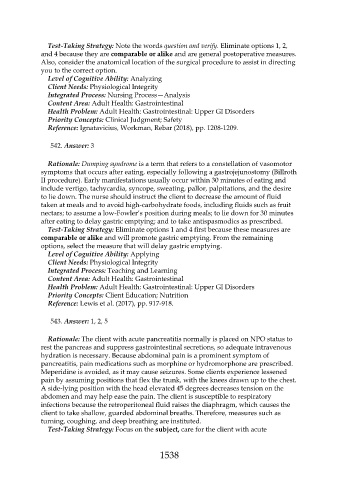Page 1538 - Saunders Comprehensive Review For NCLEX-RN
P. 1538
Test-Taking Strategy: Note the words question and verify. Eliminate options 1, 2,
and 4 because they are comparable or alike and are general postoperative measures.
Also, consider the anatomical location of the surgical procedure to assist in directing
you to the correct option.
Level of Cognitive Ability: Analyzing
Client Needs: Physiological Integrity
Integrated Process: Nursing Process—Analysis
Content Area: Adult Health: Gastrointestinal
Health Problem: Adult Health: Gastrointestinal: Upper GI Disorders
Priority Concepts: Clinical Judgment; Safety
Reference: Ignatavicius, Workman, Rebar (2018), pp. 1208-1209.
542. Answer: 3
Rationale: Dumping syndrome is a term that refers to a constellation of vasomotor
symptoms that occurs after eating, especially following a gastrojejunostomy (Billroth
II procedure). Early manifestations usually occur within 30 minutes of eating and
include vertigo, tachycardia, syncope, sweating, pallor, palpitations, and the desire
to lie down. The nurse should instruct the client to decrease the amount of fluid
taken at meals and to avoid high-carbohydrate foods, including fluids such as fruit
nectars; to assume a low-Fowler’s position during meals; to lie down for 30 minutes
after eating to delay gastric emptying; and to take antispasmodics as prescribed.
Test-Taking Strategy: Eliminate options 1 and 4 first because these measures are
comparable or alike and will promote gastric emptying. From the remaining
options, select the measure that will delay gastric emptying.
Level of Cognitive Ability: Applying
Client Needs: Physiological Integrity
Integrated Process: Teaching and Learning
Content Area: Adult Health: Gastrointestinal
Health Problem: Adult Health: Gastrointestinal: Upper GI Disorders
Priority Concepts: Client Education; Nutrition
Reference: Lewis et al. (2017), pp. 917-918.
543. Answer: 1, 2, 5
Rationale: The client with acute pancreatitis normally is placed on NPO status to
rest the pancreas and suppress gastrointestinal secretions, so adequate intravenous
hydration is necessary. Because abdominal pain is a prominent symptom of
pancreatitis, pain medications such as morphine or hydromorphone are prescribed.
Meperidine is avoided, as it may cause seizures. Some clients experience lessened
pain by assuming positions that flex the trunk, with the knees drawn up to the chest.
A side-lying position with the head elevated 45 degrees decreases tension on the
abdomen and may help ease the pain. The client is susceptible to respiratory
infections because the retroperitoneal fluid raises the diaphragm, which causes the
client to take shallow, guarded abdominal breaths. Therefore, measures such as
turning, coughing, and deep breathing are instituted.
Test-Taking Strategy: Focus on the subject, care for the client with acute
1538

